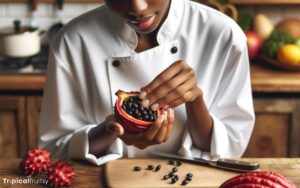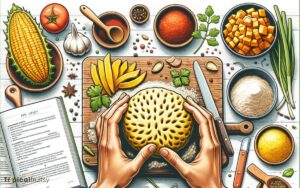How to Cook Ackee and Codfish? 7 Easy Steps!
Ackee and codfish, a quintessential Jamaican dish, is renowned for its distinctive flavors and rich cultural heritage. This culinary pairing combines the creamy, subtle fruitiness of ackee with the savory, salt-cured bite of codfish.
Preparing this dish requires a nuanced understanding of its ingredients and the delicate balance between them.
The codfish, typically salted for preservation, must be adequately desalted and flaked before cooking.
Ackee, a fruit that demands careful handling due to its toxic raw state, should be skillfully prepared to ensure safety. Seasonings and spices are selected to complement and enhance the natural flavors.
The cooking process, when followed with precision, results in a harmonious blend that is both nutritious and satisfying.
This guide is designed to navigate you through each step, ensuring a palatable experience that honors this traditional Jamaican fare.

Key Takeaway
Understanding Ackee and Codfish
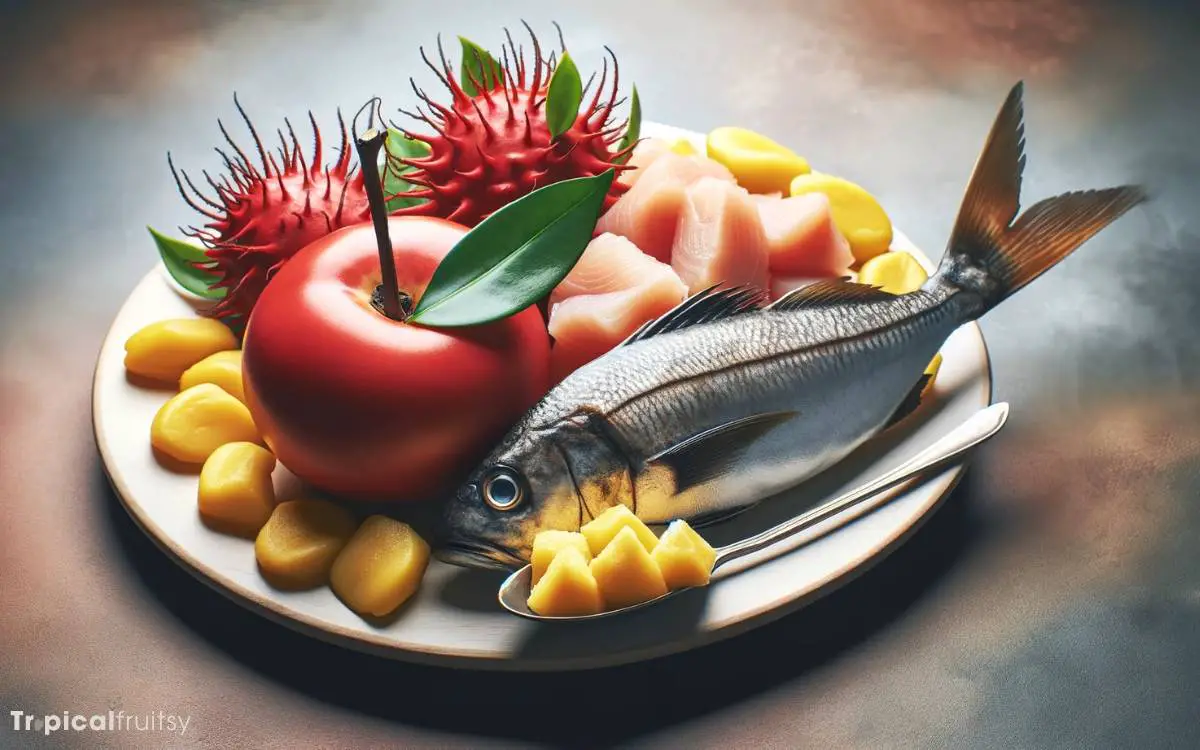
Within the culinary traditions of Jamaica, ackee and codfish represent a quintessential dish. The former is a fruit of West African origin, while the latter is a salt-cured fish known for its versatility.
Ackee, bearing a rich, buttery texture when cooked, is a staple that demands expert handling due to its toxic properties if improperly prepared.
Codfish, or saltfish, has a storied history in Caribbean cuisine, offering a robust, savory flavor that complements the delicate nature of ackee.
When these two ingredients harmonize, they create a dish that is deeply embedded in Jamaica’s cultural identity. It is celebrated for its complex flavors and nutritional value.
Mastery of this dish begins with proper ingredient selection, a critical step that ensures both safety and authenticity.
Step 1: Ingredient Selection Tips
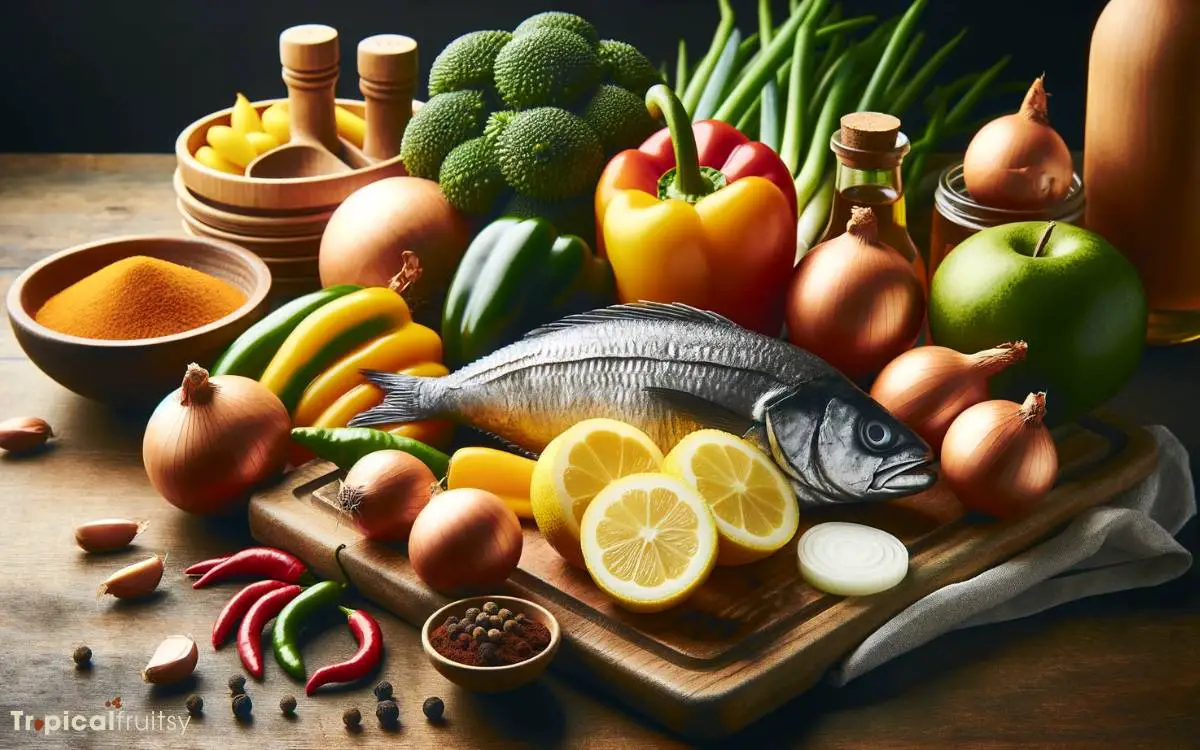
Selecting the highest quality ackee and codfish is crucial for the success of this iconic Jamaican dish. The delicate balance of flavors and textures relies on the freshness and authenticity of these key components.
When sourcing your ingredients, consider these vital tips:
- Ackee: Opt for fresh ackee when in season; it should be bright red to yellow-orange and should split open naturally. Canned ackee, a more accessible alternative, must be firm and buttery yellow, not brown or mushy.
- Codfish: Seek out salt cod that is dry and intact, with a clean, white appearance. Avoid any pieces that look excessively yellowed or have a strong, off-putting odor.
- Complementary Ingredients: Fresh herbs and aromatic spices should be vibrant in color and aroma, ensuring they contribute the intended depth to the dish.
Step 2: Preparing the Codfish
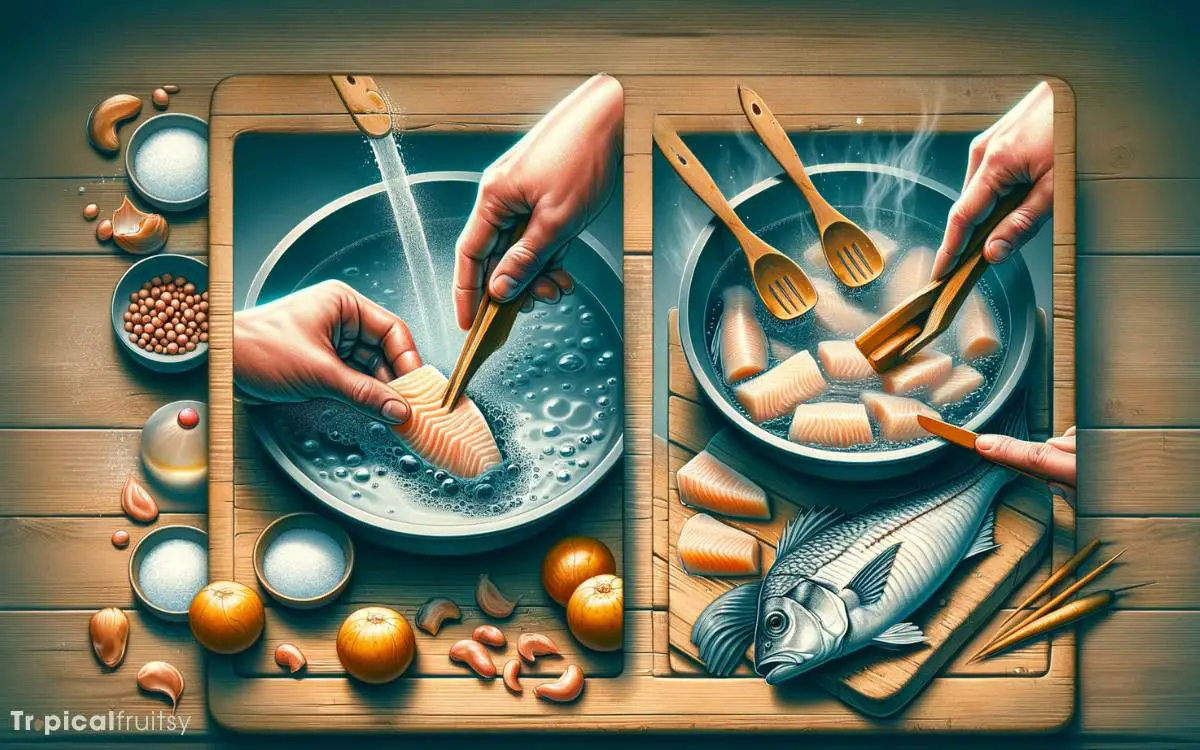
Proper preparation of codfish is essential for achieving the traditional flavor and texture that complements the creamy profile of ackee.
The desalting process is a critical initial step, requiring the cod to be soaked in water for an extended period, with periodic water changes to remove excess salt.
Subsequently, employing the correct cooking techniques ensures that the codfish retains its delicate flakiness without becoming tough or dry.
Desalting Process Tips
Why is it crucial to desalt codfish thoroughly before combining it with ackee in this traditional dish?
Codfish, especially when preserved through salting, carries an intense concentration of sodium. To ensure the subtleties of the ackee’s creamy texture and delicate flavor are not overpowered, the cod must be desalted adequately.
Here are essential tips for desalting:
- Soak the codfish in cold water for at least 24 hours, changing the water several times to leach out the salt.
- Taste the water after several hours; a noticeable reduction in saltiness indicates the process is working.
- For those pressed for time, briefly boil the codfish and discard the water, repeating if necessary.
Codfish Cooking Techniques
After desalting the codfish, gently simmer it in fresh water for about 20 minutes to achieve the ideal flakiness without it falling apart.
This stage is critical for ensuring that the codfish retains its structural integrity while becoming tender enough to meld seamlessly with the creamy texture of the ackee.
It’s essential to use a low and steady heat to avoid toughening the protein. Monitor the water’s simmer, never allowing it to boil vigorously, as this can cause the codfish to break into too-small pieces, ruining the intended texture of the dish.
The practiced care in this step speaks to the culinary respect for the ingredient’s quality and the final dish’s textural balance.
Step 3: Ackee Preparation Safety
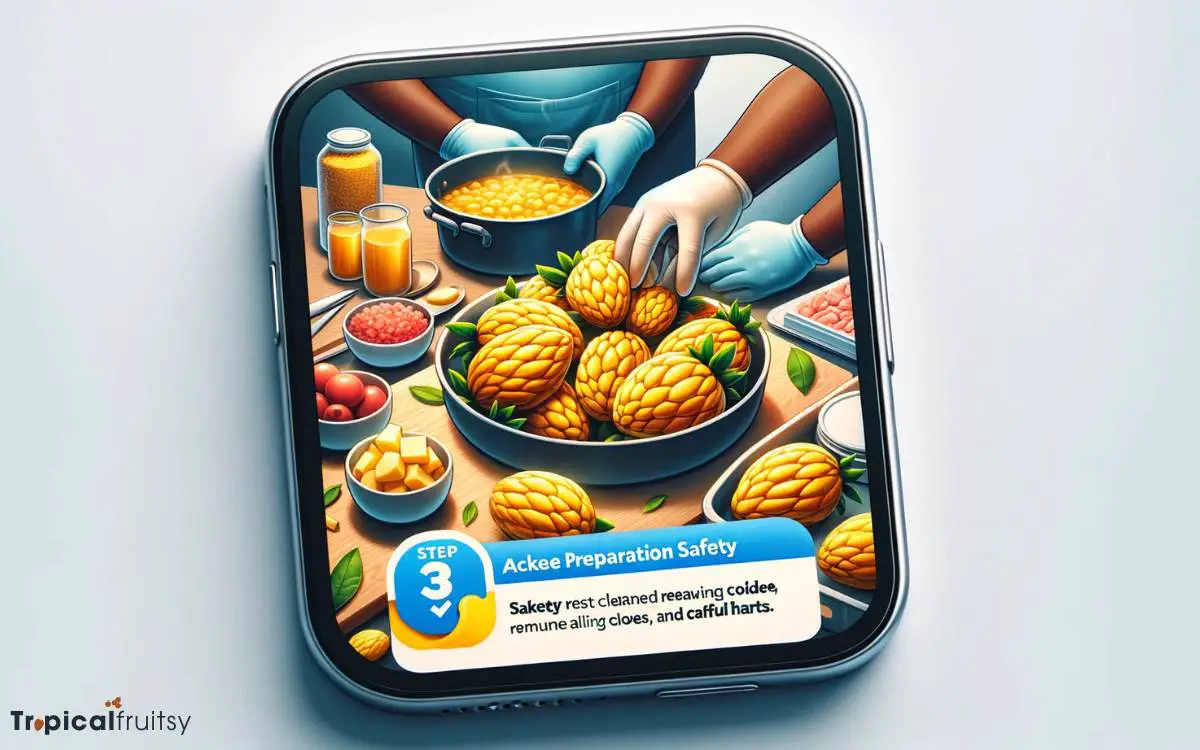
Ensuring the safety of ackee preparation is crucial due to the fruit’s toxic properties when improperly handled.
Ackee, the national fruit of Jamaica, contains hypoglycin A, a toxin that can lead to severe health consequences known as ‘Jamaican Vomiting Sickness’ if consumed before it is fully ripe.
It is imperative to follow strict safety measures:
- Wait for Natural Ripening: Only harvest ackee when it has naturally opened on the tree. Unripe ackee is highly toxic.
- Remove All Inedible Parts: After the ackee has opened, discard the seeds and the pink membrane as they contain dangerous toxins.
- Cook Thoroughly: Always boil the ackee fruit for at least 30 minutes to destroy any remaining toxins before consuming.
These guidelines will help ensure a safe and enjoyable experience when preparing this traditional dish.
Step 4: Seasoning and Spices Guide
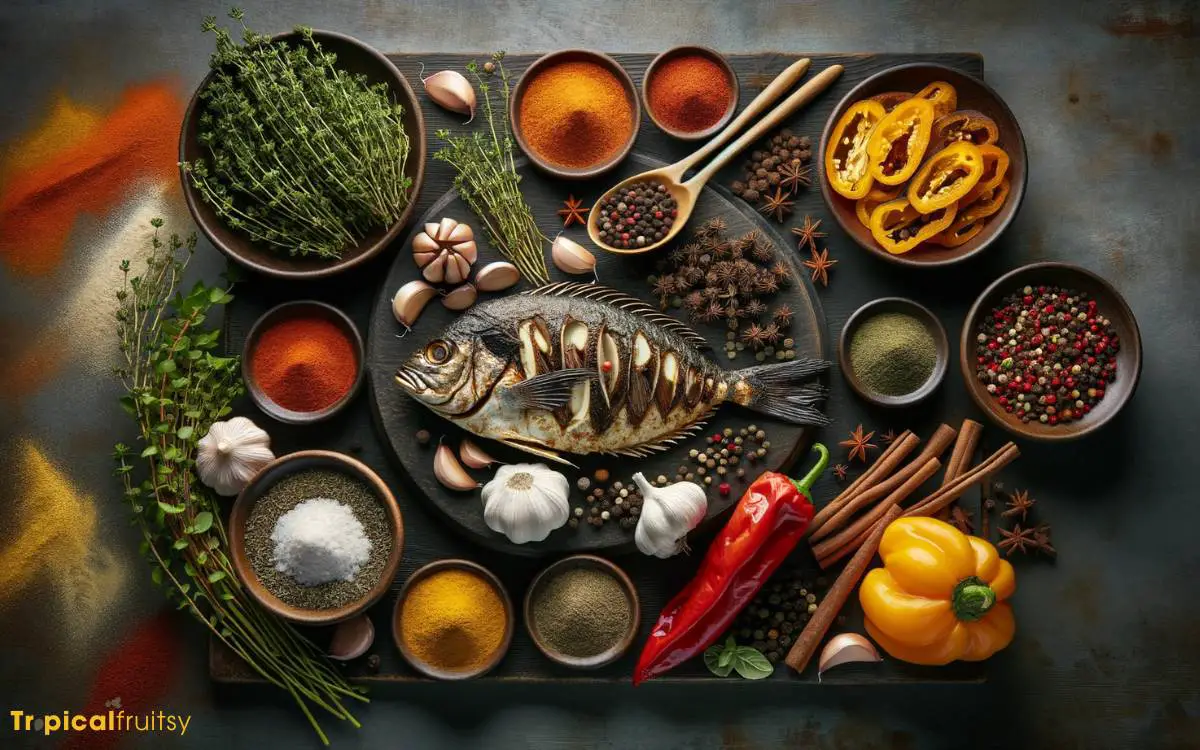
The judicious application of seasonings and spices is crucial in achieving the authentic taste of Ackee and Codfish, a revered staple in Caribbean cuisine.
Selecting genuine, high-quality spices not only enhances the dish’s flavor profile but also ensures a culinary experience true to its Jamaican roots.
Understanding how to balance the robust flavors and adjust the spice heat levels to suit individual palates is essential in preparing this iconic dish.
Choosing Authentic Spices
Selecting the right combination of spices is crucial for achieving the authentic flavor of traditional Jamaican ackee and codfish.
To ensure the integrity of this iconic dish, one must be meticulous in choosing high-quality spices that epitomize Jamaican cuisine’s rich and vibrant character.
Consider incorporating the following:
- Scotch Bonnet Pepper: This quintessential Caribbean pepper offers a fiery heat and a hint of sweetness, essential for the dish’s signature kick.
- Thyme: Fresh thyme imparts a subtle earthiness that complements the creaminess of ackee and the saltiness of the codfish.
- Allspice: Ground allspice, also known as pimento, adds a warm, aromatic depth without overpowering the dish’s delicate balance.
Balancing Flavors
Mastering the delicate art of seasoning is essential when combining spices such as Scotch Bonnet pepper, thyme, and allspice to create a perfectly balanced ackee and codfish dish. The key to achieving harmony lies in understanding the flavor profile of each ingredient.
Scotch Bonnet peppers add a fiery kick, which must be tempered to prevent overpowering the mild, buttery taste of ackee and the saltiness of the codfish.
Thyme contributes earthy and floral notes, while allspice brings a warm, nutmeg-cinnamon like complexity.
Measuring these seasonings with precision ensures that no single flavor dominates the dish. It is a dance of subtlety and strength, where each spice has its place and purpose.
Spice Heat Levels
Understanding spice heat levels is crucial when integrating Scotch Bonnet peppers into the ackee and codfish dish to maintain its traditional zest without overwhelming the palate.
These peppers are known for their fiery heat, which can significantly alter the flavor profile of a dish if not used judiciously.
Here are key considerations:
- Scoville Heat Units (SHU): Scotch Bonnet peppers typically range from 100,000 to 350,000 SHU, indicating a high level of pungency.
- Pepper Quantity: Use sparingly; a small amount can impart the desired heat without overpowering other flavors.
- Cooking Time: Adding the pepper early in the cooking process can mellow its heat, while introducing it later preserves more of its intensity.
Adhering to these guidelines will ensure the ackee and codfish dish is authentically spiced, offering a pleasurable experience to those familiar and new to this culinary treasure.
Step 5: Cooking Method Explained
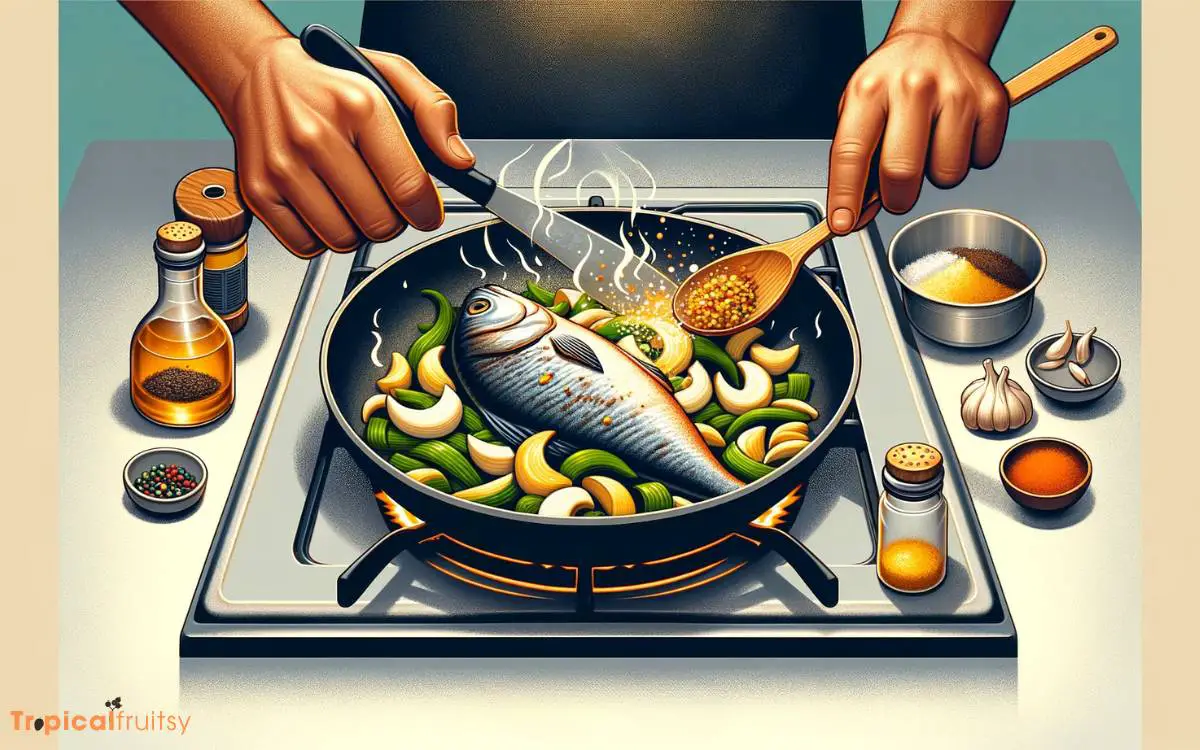
The cooking process for ackee and codfish involves several steps.
First, the salted cod needs to be prepared. It can be soaked overnight to reduce its intense salinity. Alternatively, it can be boiled in water for about 20 minutes until it reaches a palatable level of saltiness.
After soaking, the codfish is flaked, with bones and skin meticulously removed.
Concurrently, the ackee needs to be prepared. If using canned ackee, it simply needs to be drained. However, if using fresh ackee, it must be boiled until tender. Care should be taken to avoid overcooking, as this can render the ackee mushy.
In a skillet, finely chopped onions, scallions, peppers, and garlic are sautéed until fragrant.
Next, the flaked codfish is added to the skillet, stirring until it is well mixed with the aromatics.
Lastly, the ackee is gently folded in, allowing it to warm through without breaking apart. This step is important to ensure that the dish retains its iconic texture and visual appeal.
Step 6: Serving Suggestions

One may enhance the enjoyment of ackee and codfish by pairing it with complementary sides such as fluffy white rice or traditional Jamaican hard dough bread.
To fully appreciate the dish’s cultural richness and flavor profile, consider incorporating the following traditional accompaniments:
- Fried Dumplings: These golden-brown delights offer a satisfying crunch and a soft interior that absorbs the flavors of the ackee and codfish.
- Fried Plantains: Their sweet caramelization contrasts the dish’s savory notes, providing a delightful balance to the palate.
- Steamed Callaloo: This leafy green vegetable, akin to spinach, introduces a subtle, earthy component that complements the meal’s overall heartiness.
These sides not only provide a symphony of textures and tastes but also root the experience in authentic Jamaican culinary tradition.
Can I Substitute Red Herring for Codfish in the Ackee Dish?
Yes, you can substitute red herring for codfish in the ackee dish. Red herring adds a unique and smoky flavor to the dish. Try this easy red herring ackee recipe for a delicious twist on a classic Jamaican dish.
Step 7: Storage and Leftovers
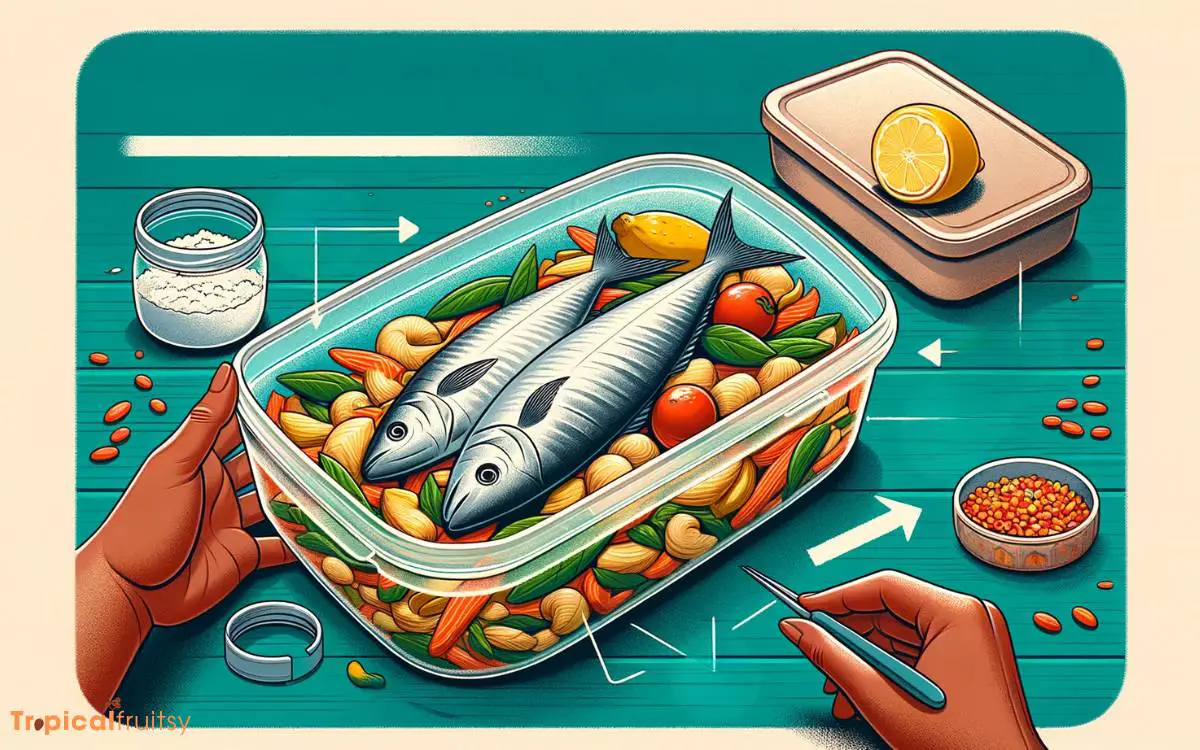
Proper storage of any remaining ackee and codfish is crucial for maintaining its freshness and safety for consumption.
After serving, leftovers should be cooled to room temperature promptly—within two hours—to prevent bacterial growth.
The ackee and codfish mixture must then be transferred to airtight containers and refrigerated. When stored correctly at or below 40°F (4°C), the dish can be safely consumed within three to four days.
To reheat, bring the leftovers to a simmer on the stove, reaching an internal temperature of 165°F (74°C) to ensure that any potential bacteria are destroyed.
Under no circumstances should ackee and codfish be left out overnight or reheated multiple times, as this increases the risk of foodborne illness.
Conclusion
In the fusion of ackee’s creamy texture with the saltiness of codfish lies a quintessential dish of Caribbean heritage.
Through careful selection of ingredients, meticulous preparation, and the harmonious blend of spices, this culinary masterpiece comes to life.
It stands not only as a testament to the region’s history but also as an embodiment of its cultural synthesis.
Proper storage ensures the dish’s longevity, inviting one to revisit the flavors that encapsulate the spirit of Caribbean cuisine.

